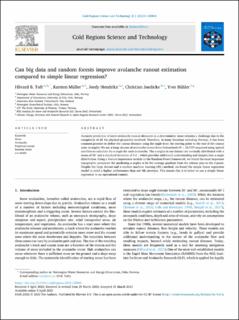| dc.contributor.author | Toft, Håvard B. | |
| dc.contributor.author | Müller, Karsten | |
| dc.contributor.author | Hendrikx, Jordy | |
| dc.contributor.author | Jaedicke, Christian | |
| dc.contributor.author | Bühler, Yves | |
| dc.date.accessioned | 2023-06-02T07:18:56Z | |
| dc.date.available | 2023-06-02T07:18:56Z | |
| dc.date.created | 2023-05-10T09:48:46Z | |
| dc.date.issued | 2023 | |
| dc.identifier.citation | Cold Regions Science and Technology. 2023, 211 . | |
| dc.identifier.issn | 0165-232X | |
| dc.identifier.uri | https://hdl.handle.net/11250/3069706 | |
| dc.description.abstract | Accurate prediction of snow avalanche runout-distances in a deterministic sense remains a challenge due to the complexity of all the physical properties involved. Therefore, in many locations including Norway, it has been common practice to define the runout distance using the angle from the starting point to the end of the runout zone (α-angle). We use a large dataset of avalanche events from Switzerland (N = 18,737) acquired using optical satellites to calculate the α-angle for each avalanche. The α-angles in our dataset are normally distributed with a mean of 33° and a standard deviation of 6.1°, which provides additional understanding and insights into α-angle distribution. Using a feature importance module in the Random Forest framework, we found the most important topographic parameter for predicting α-angles to be the average gradient from the release area to the β-point. Despite the large dataset and a modern machine learning (ML) method, we found the simple linear regression model to yield a higher performance than our ML attempts. This means that it is better to use a simple linear regression in an operational context | |
| dc.language.iso | eng | |
| dc.title | Can big data and random forests improve avalanche runout estimation compared to simple linear regression? | |
| dc.title.alternative | Can big data and random forests improve avalanche runout estimation compared to simple linear regression? | |
| dc.type | Peer reviewed | |
| dc.type | Journal article | |
| dc.description.version | publishedVersion | |
| dc.source.pagenumber | 17 | |
| dc.source.volume | 211 | |
| dc.source.journal | Cold Regions Science and Technology | |
| dc.identifier.doi | 10.1016/j.coldregions.2023.103844 | |
| dc.identifier.cristin | 2146676 | |
| cristin.ispublished | true | |
| cristin.fulltext | original | |
| cristin.qualitycode | 2 | |
